2009 RENAULT TWINGO sensor
[x] Cancel search: sensorPage 132 of 348
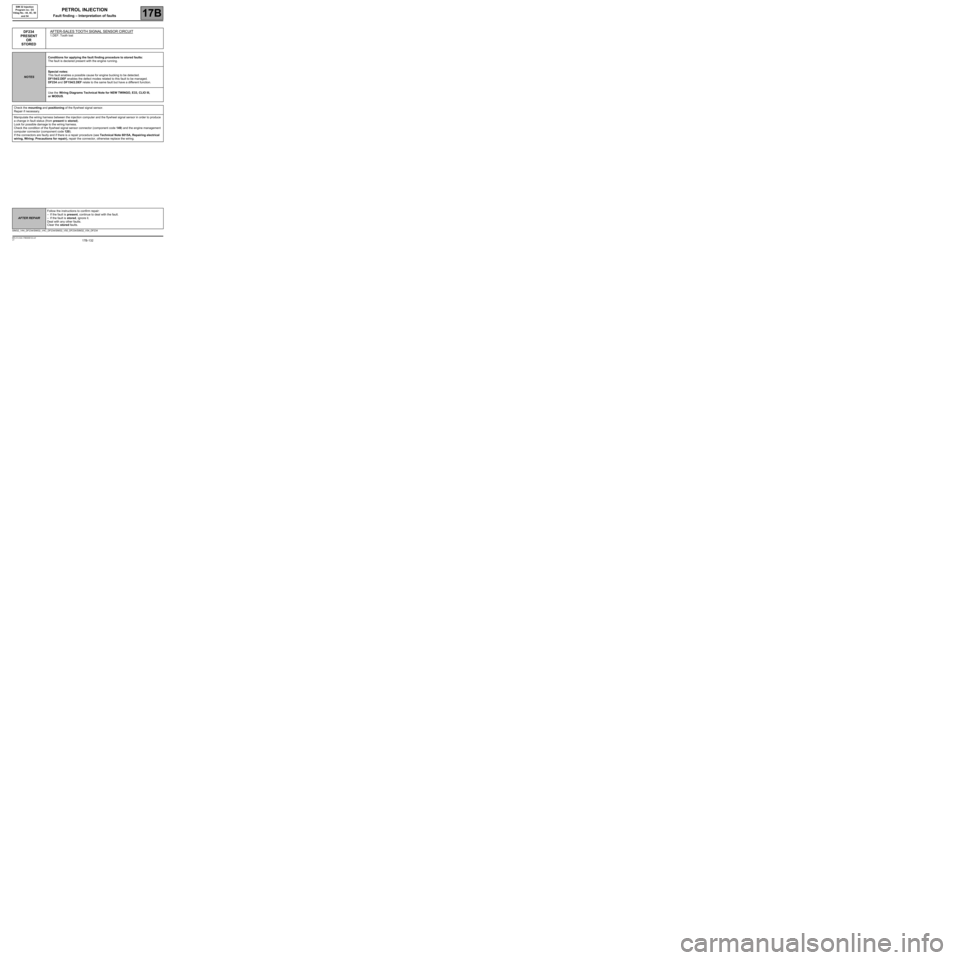
17B-132V7 MR-413-X44-17B000$133.mif
PETROL INJECTION
Fault finding – Interpretation of faults17B
SIM 32 Injection
Program no.: D3
Vdiag No.: 44, 4C, 50
and 54
DF234
PRESENT
OR
STOREDAFTER-SALES TOOTH SIGNAL SENSOR CIRCUIT
1.DEF: Tooth lost
NOTESConditions for applying the fault finding procedure to stored faults:
The fault is declared present with the engine running.
Special notes:
This fault enables a possible cause for engine bucking to be detected.
DF154/2.DEF enables the defect modes related to this fault to be managed.
DF234 and DF154/2.DEF relate to the same fault but have a different function.
Use the Wiring Diagrams Technical Note for NEW TWINGO, E33, CLIO III,
or MODUS.
Check the mounting and positioning of the flywheel signal sensor.
Repair if necessary.
Manipulate the wiring harness between the injection computer and the flywheel signal sensor in order to produce
a change in fault status (from present to stored).
Look for possible damage to the wiring harness.
Check the condition of the flywheel signal sensor connector (component code 149) and the engine management
computer connector (component code 120).
If the connectors are faulty and if there is a repair procedure (see Technical Note 6015A, Repairing electrical
wiring, Wiring: Precautions for repair), repair the connector, otherwise replace the wiring.
SIM32_V44_DF234/SIM32_V4C_DF234/SIM32_V50_DF234/SIM32_V54_DF234
AFTER REPAIRFollow the instructions to confirm repair:
–If the fault is present, continue to deal with the fault.
–If the fault is stored, ignore it.
Deal with any other faults.
Clear the stored faults.
Page 133 of 348
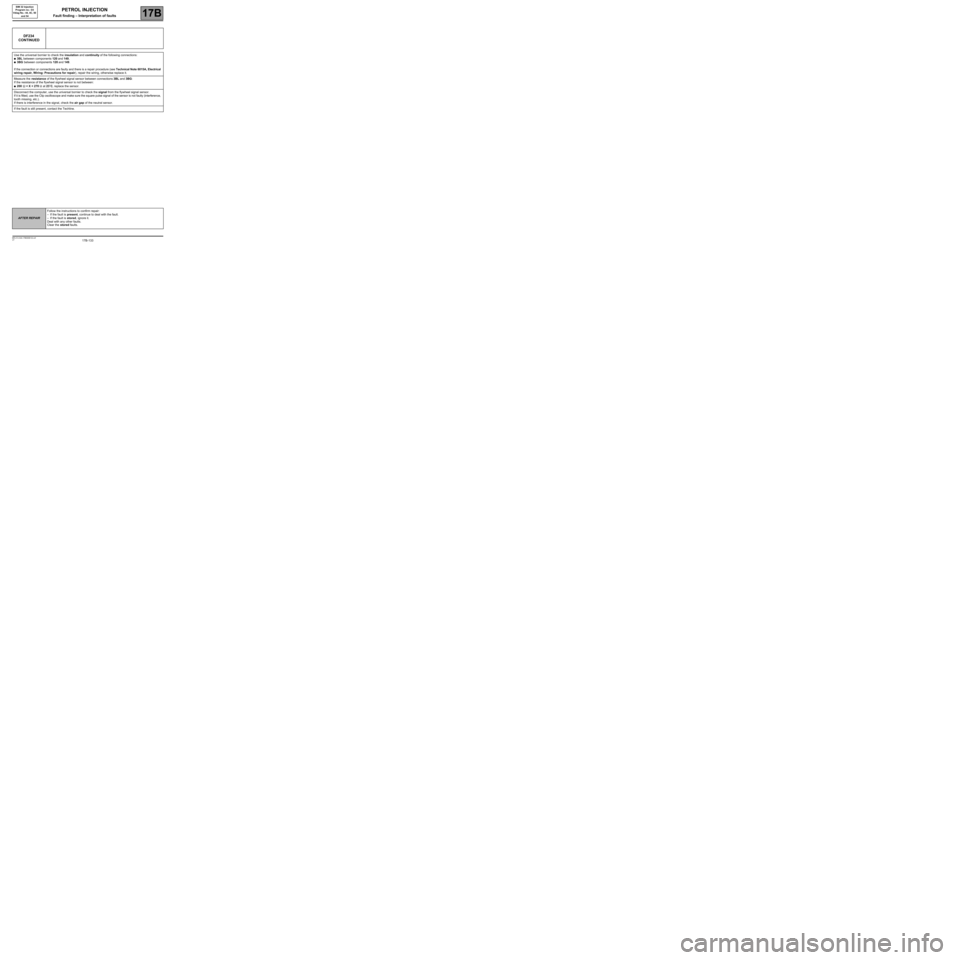
17B-133V7 MR-413-X44-17B000$133.mif
PETROL INJECTION
Fault finding – Interpretation of faults17B
SIM 32 Injection
Program no.: D3
Vdiag No.: 44, 4C, 50
and 54
DF234
CONTINUED
Use the universal bornier to check the insulation and continuity of the following connections:
●3BL between components 120 and 149,
●3BG between components 120 and 149.
If the connection or connections are faulty and there is a repair procedure (see Technical Note 6015A, Electrical
wiring repair, Wiring: Precautions for repair), repair the wiring, otherwise replace it.
Measure the resistance of the flywheel signal sensor between connections 3BL and 3BG:
If the resistance of the flywheel signal sensor is not between:
●200 Ω < X < 270 Ω at 23˚C, replace the sensor.
Disconnect the computer, use the universal bornier to check the signal from the flywheel signal sensor.
If it is fitted, use the Clip oscilloscope and make sure the square pulse signal of the sensor is not faulty (interference,
tooth missing, etc.).
If there is interference in the signal, check the air gap of the neutral sensor.
If the fault is still present, contact the Techline.
AFTER REPAIRFollow the instructions to confirm repair:
–If the fault is present, continue to deal with the fault.
–If the fault is stored, ignore it.
Deal with any other faults.
Clear the stored faults.
Page 134 of 348
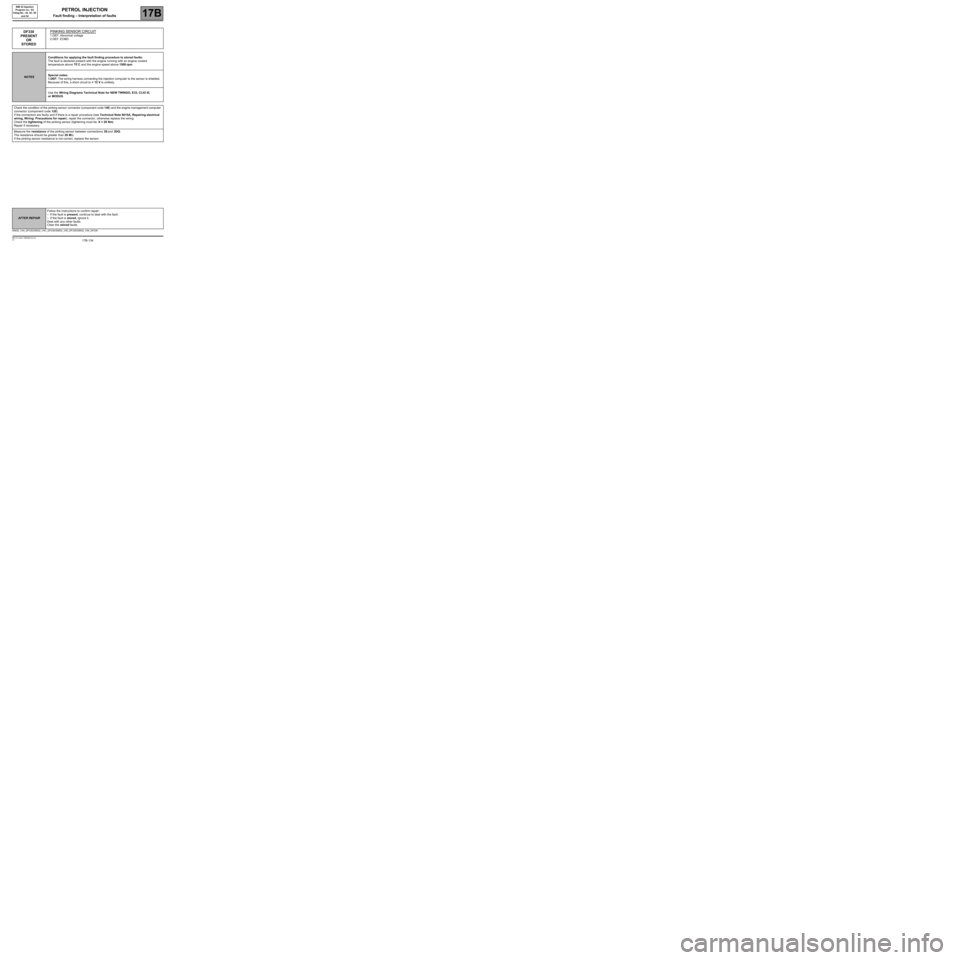
17B-134V7 MR-413-X44-17B000$133.mif
PETROL INJECTION
Fault finding – Interpretation of faults17B
SIM 32 Injection
Program no.: D3
Vdiag No.: 44, 4C, 50
and 54
DF330
PRESENT
OR
STOREDPINKING SENSOR CIRCUIT
1.DEF: Abnormal voltage
2.DEF: EOBD
NOTESConditions for applying the fault finding procedure to stored faults:
The fault is declared present with the engine running with an engine coolant
temperature above 75˚C and the engine speed above 1500 rpm.
Special notes:
1.DEF: The wiring harness connecting the injection computer to the sensor is shielded.
Because of this, a short circuit to + 12 V is unlikely.
Use the Wiring Diagrams Technical Note for NEW TWINGO, E33, CLIO III,
or MODUS.
Check the condition of the pinking sensor connector (component code 146) and the engine management computer
connector (component code 120).
If the connectors are faulty and if there is a repair procedure (see Technical Note 6015A, Repairing electrical
wiring, Wiring: Precautions for repair), repair the connector, otherwise replace the wiring.
Check the tightening of the pinking sensor (tightening must be: X = 20 Nm).
Repair if necessary.
Measure the resistance of the pinking sensor between connections 3S and 3DQ:
The resistance should be greater than 20 MΩ.
If the pinking sensor resistance is not correct, replace the sensor.
SIM32_V44_DF330/SIM32_V4C_DF330/SIM32_V50_DF330/SIM32_V54_DF330
AFTER REPAIRFollow the instructions to confirm repair:
–If the fault is present, continue to deal with the fault.
–If the fault is stored, ignore it.
Deal with any other faults.
Clear the stored faults.
Page 135 of 348

17B-135V7 MR-413-X44-17B000$133.mif
PETROL INJECTION
Fault finding – Interpretation of faults17B
SIM 32 Injection
Program no.: D3
Vdiag No.: 44, 4C, 50
and 54
DF330
CONTINUEDPINKING SENSOR CIRCUIT1.DEF: Abnormal voltage
2.DEF: EOBD
Use the universal bornier to check the insulation and continuity of the following connections:
●3S between components 120 and 146,
●3DQ between components 120 and 146.
If the connection or connections are faulty and there is a repair procedure (see Technical Note 6015A, Electrical
wiring repair, Wiring: Precautions for repair), repair the wiring, otherwise replace it.
Check the conformity of the fuel in the tank, apply test 1 Petrol conformity check.
Check that the spark plugs are correct.
Repair if necessary.
AFTER REPAIRFollow the instructions to confirm repair:
–If the fault is present, continue to deal with the fault.
–If the fault is stored, ignore it.
Deal with any other faults.
Clear the stored faults.
Page 143 of 348
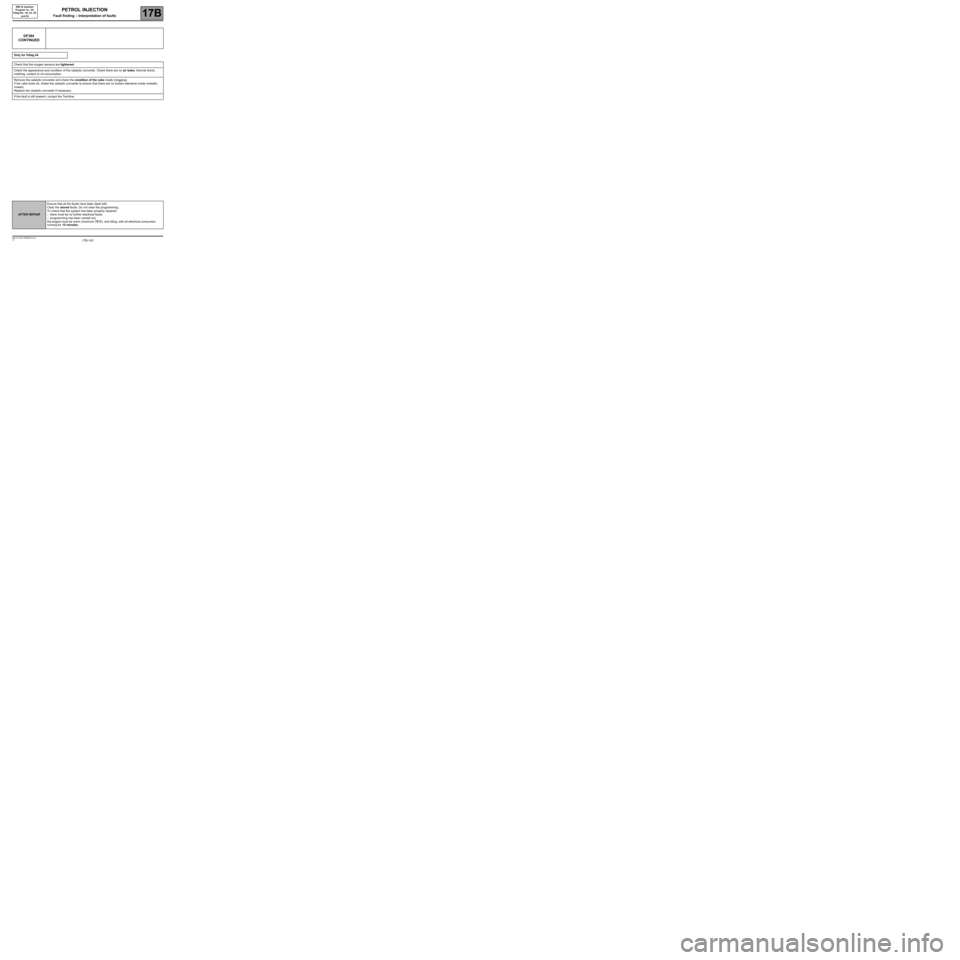
17B-143V7 MR-413-X44-17B000$133.mif
PETROL INJECTION
Fault finding – Interpretation of faults17B
SIM 32 Injection
Program no.: D3
Vdiag No.: 44, 4C, 50
and 54
DF394
CONTINUED
Only for Vdiag 44
Check that the oxygen sensors are tightened.
Check the appearance and condition of the catalytic converter. Check there are no air leaks, thermal shock,
misfiring, coolant or oil consumption.
Remove the catalytic converter and check the condition of the cake inside (clogging).
If the cake looks ok, shake the catalytic converter to ensure that there are no broken elements inside (metallic
noises).
Replace the catalytic converter if necessary.
If the fault is still present, contact the Techline.
AFTER REPAIREnsure that all the faults have been dealt with.
Clear the stored faults. Do not clear the programming.
To check that the system has been properly repaired:
–there must be no further electrical faults,
–programming has been carried out,
the engine must be warm (minimum 75˚C), and idling, with all electrical consumers
running for 15 minutes.
Page 146 of 348
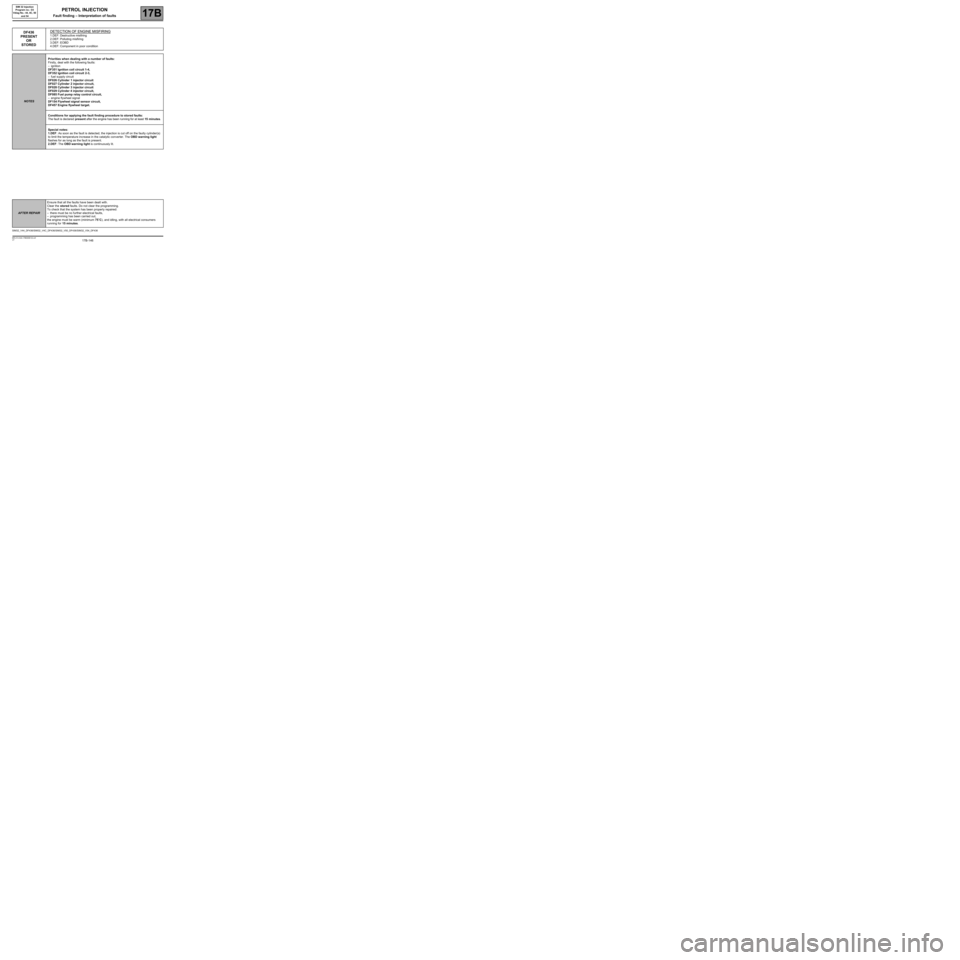
17B-146V7 MR-413-X44-17B000$133.mif
PETROL INJECTION
Fault finding – Interpretation of faults17B
SIM 32 Injection
Program no.: D3
Vdiag No.: 44, 4C, 50
and 54
DF436
PRESENT
OR
STOREDDETECTION OF ENGINE MISFIRING1.DEF: Destructive misfiring
2.DEF: Polluting misfiring
3.DEF: EOBD
4.DEF: Component in poor condition
NOTESPriorities when dealing with a number of faults:
Firstly, deal with the following faults:
–ignition
DF351 Ignition coil circuit 1-4,
DF352 Ignition coil circuit 2-3,
–fuel supply circuit
DF026 Cylinder 1 injector circuit
DF027 Cylinder 2 injector circuit,
DF028 Cylinder 3 injector circuit
DF029 Cylinder 4 injector circuit,
DF085 Fuel pump relay control circuit,
–engine flywheel signal
DF154 Flywheel signal sensor circuit,
DF457 Engine flywheel target.
Conditions for applying the fault finding procedure to stored faults:
The fault is declared present after the engine has been running for at least 15 minutes.
Special notes:
1.DEF: As soon as the fault is detected, the injection is cut off on the faulty cylinder(s)
to limit the temperature increase in the catalytic converter. The OBD warning light
flashes for as long as the fault is present.
2.DEF: The OBD warning light is continuously lit.
SIM32_V44_DF436/SIM32_V4C_DF436/SIM32_V50_DF436/SIM32_V54_DF436
AFTER REPAIREnsure that all the faults have been dealt with.
Clear the stored faults. Do not clear the programming.
To check that the system has been properly repaired:
–there must be no further electrical faults,
–programming has been carried out,
the engine must be warm (minimum 75˚C), and idling, with all electrical consumers
running for 15 minutes.
Page 147 of 348
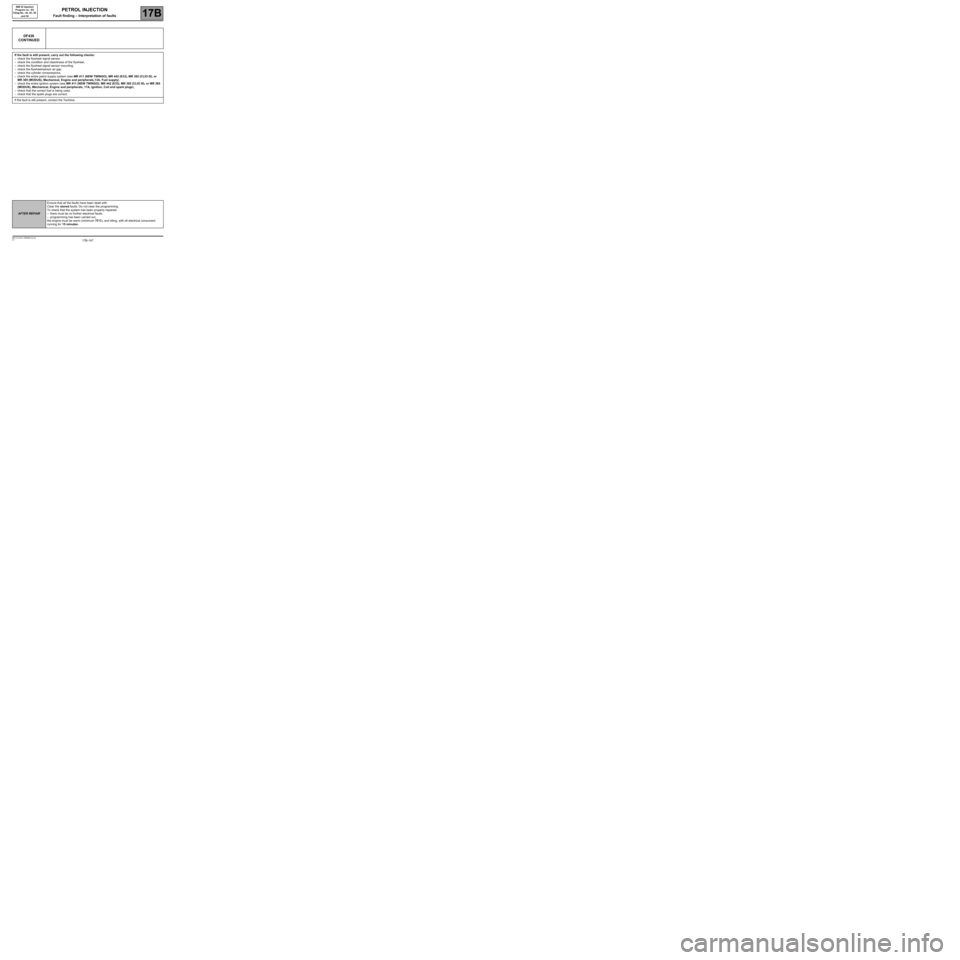
17B-147V7 MR-413-X44-17B000$133.mif
PETROL INJECTION
Fault finding – Interpretation of faults17B
SIM 32 Injection
Program no.: D3
Vdiag No.: 44, 4C, 50
and 54
DF436
CONTINUED
If the fault is still present, carry out the following checks:
–check the flywheel signal sensor,
–check the condition and cleanliness of the flywheel,
–check the flywheel signal sensor mounting,
–check the flywheel/sensor air gap
–check the cylinder compressions,
–check the entire petrol supply system (see MR 411 (NEW TWINGO), MR 442 (E33), MR 392 (CLIO III), or
MR 385 (MODUS), Mechanical, Engine and peripherals,13A, Fuel supply),
–check the entire ignition system (see MR 411 (NEW TWINGO), MR 442 (E33), MR 392 (CLIO III), or MR 385
(MODUS), Mechanical, Engine and peripherals, 17A, Ignition, Coil and spark plugs),
–check that the correct fuel is being used,
–check that the spark plugs are correct.
If the fault is still present, contact the Techline.
AFTER REPAIREnsure that all the faults have been dealt with.
Clear the stored faults. Do not clear the programming.
To check that the system has been properly repaired:
–there must be no further electrical faults,
–programming has been carried out,
the engine must be warm (minimum 75˚C), and idling, with all electrical consumers
running for 15 minutes.
Page 149 of 348
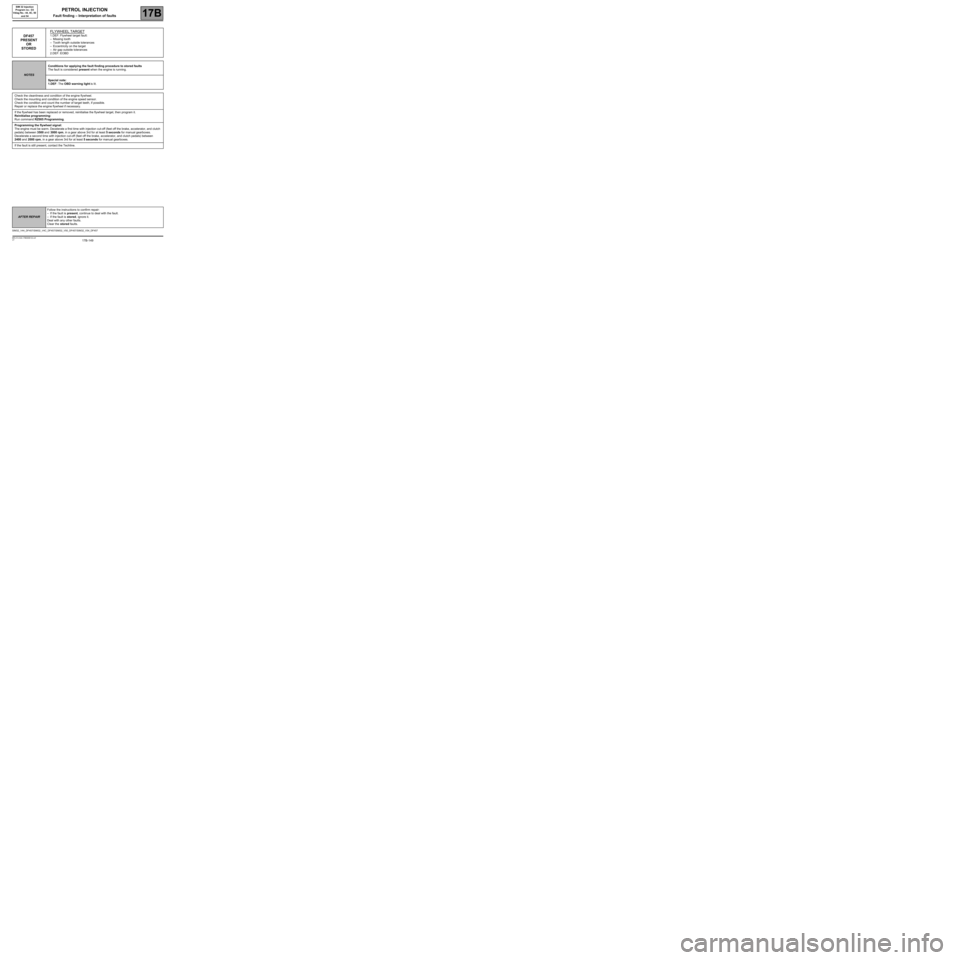
17B-149V7 MR-413-X44-17B000$133.mif
PETROL INJECTION
Fault finding – Interpretation of faults17B
SIM 32 Injection
Program no.: D3
Vdiag No.: 44, 4C, 50
and 54
DF457
PRESENT
OR
STOREDFLYWHEEL TARGET1.DEF: Flywheel target fault:
–Missing tooth
–Tooth length outside tolerances
–Eccentricity on the target
–Air gap outside tolerances
2.DEF: EOBD
NOTESConditions for applying the fault finding procedure to stored faults
The fault is considered present when the engine is running.
Special note:
1.DEF: The OBD warning light is lit.
Check the cleanliness and condition of the engine flywheel.
Check the mounting and condition of the engine speed sensor.
Check the condition and count the number of target teeth, if possible.
Repair or replace the engine flywheel if necessary.
If the flywheel has been replaced or removed, reinitialise the flywheel target, then program it.
Reinitialise programming:
Run command RZ005 Programming.
Programming the flywheel signal:
The engine must be warm. Decelerate a first time with injection cut-off (feet off the brake, accelerator, and clutch
pedals) between 3500 and 3000 rpm, in a gear above 3rd for at least 5 seconds for manual gearboxes.
Decelerate a second time with injection cut-off (feet off the brake, accelerator, and clutch pedals) between
2400 and 2000 rpm, in a gear above 3rd for at least 5 seconds for manual gearboxes.
If the fault is still present, contact the Techline.
SIM32_V44_DF457/SIM32_V4C_DF457/SIM32_V50_DF457/SIM32_V54_DF457
AFTER REPAIRFollow the instructions to confirm repair:
–If the fault is present, continue to deal with the fault.
–If the fault is stored, ignore it.
Deal with any other faults.
Clear the stored faults.